You are using an out of date browser. It may not display this or other websites correctly.
You should upgrade or use an alternative browser.
You should upgrade or use an alternative browser.
cant cam over bolt
- Thread starter wayupnorth
- Start date
It's not impossible the Lyman FL die is faulty, but it's not likely. A FL sizer will only FL size if it is adjusted to do so. It's up to the operator to adjust it properly for your brass and rifles.i should say, i believe we are full length resizing and not just shoulder bumping but i may be wrong.
we are running them through the Hornady Fully Length die, which should by the name be a full resizing if im correnct.
This^OP
You are going round and round and round in circles.
The problem is a headspace problem with your sized cases. STOP loading up ammo and size the damn cases until they fit into the chamber without a bullet seated.
NONE of the things you have discussed would cause the problem you describe. The only thing that would hard stop the bolt closing is a case that is sized too long ... ie a headspace problem
As others have said look at:
1) Proper shoulder bump (I shoot for 0.002" back)
2) Proper full length resizing right to the base of the case
3) Verify case length and trim if required (may have grown and are now too long for chamber)
4) Could the bullets be accidentally / on purpose be seated longer than previously? If so they would hit / jam into the lands and make it hard to close the bolt.
5) Work hardened necks that despite being resized "spring back" and are tight / too big for the chamber (but if you are getting decent neck tension it probably aint this). Eventually if you keep using the same brass without annealing you will experience this (been there / done that).
6) This is an odd one and probably unlikely but check for peening on the case mouth. Depending on how the cases are cleaned (have seen it in a wet tumbler without pins to cushion the cases from bashing each other) the case mouths can be peened (bashed to the point that there is a slight rim / lip) and it a tight chamber that can be enough to cause issues. I have one rifle that I have experienced this exact issue.
Also, as other have mentioned start with a prepped case and try putting it in the gun to see if there are any issues (that would eliminate a case prep issue and I suspect the issue lies here) before loading and trying again.
Good luck.
1) Proper shoulder bump (I shoot for 0.002" back)
2) Proper full length resizing right to the base of the case
3) Verify case length and trim if required (may have grown and are now too long for chamber)
4) Could the bullets be accidentally / on purpose be seated longer than previously? If so they would hit / jam into the lands and make it hard to close the bolt.
5) Work hardened necks that despite being resized "spring back" and are tight / too big for the chamber (but if you are getting decent neck tension it probably aint this). Eventually if you keep using the same brass without annealing you will experience this (been there / done that).
6) This is an odd one and probably unlikely but check for peening on the case mouth. Depending on how the cases are cleaned (have seen it in a wet tumbler without pins to cushion the cases from bashing each other) the case mouths can be peened (bashed to the point that there is a slight rim / lip) and it a tight chamber that can be enough to cause issues. I have one rifle that I have experienced this exact issue.
Also, as other have mentioned start with a prepped case and try putting it in the gun to see if there are any issues (that would eliminate a case prep issue and I suspect the issue lies here) before loading and trying again.
Good luck.
wayupnorth, you mention you have trimmed already
but you also mention a detail of difference between the 2 batches feels like the case mouth bump or flair
Is it possible the seater die is good for crimping also and some loads the die is too low and starts a crimp on a bullet without a cannelure
this would cause a slight bulge in the brass neck at or near the case mouth
maybe measure the neck od of the loaded rounds
but you also mention a detail of difference between the 2 batches feels like the case mouth bump or flair
Is it possible the seater die is good for crimping also and some loads the die is too low and starts a crimp on a bullet without a cannelure
this would cause a slight bulge in the brass neck at or near the case mouth
maybe measure the neck od of the loaded rounds
wayupnorth
CGN Ultra frequent flyer
- Location
- Northern Alberta
sorry for the delay on getting back.
so i went and painted up a couple of the rounds that would not cam over with a black sharpie and then put them in.
i noticed 2 things.
1) when the bullets had ink on them i was able to cam them over.... they where tight but i was able to close it.
2) i got some marks on the bullet on the ogive i believe
let me see if i can post a couple of the pics. (see pics below)
now, these are not the bullets i use.
these are test ladders that my dad was doing so these are Barnes TTSX.
over tea this morning we were discussing this and i noticed that it was just the TTSX bullets that where getting stuck.
i was supirsed that the sharpie test showed they where dragging at the ogive and not getting stuck at the rim, could this just be a simple matter that the TTSX bullets are a little wider or wide enough that they happen to be TOO wide for our specific rifles?
i dont have a micrometer small enough to measure the width with accuracy, i ordered one off of amazon this morning.
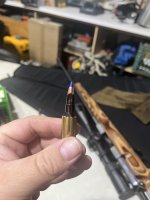
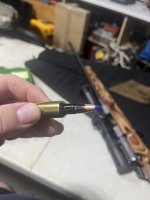
so i went and painted up a couple of the rounds that would not cam over with a black sharpie and then put them in.
i noticed 2 things.
1) when the bullets had ink on them i was able to cam them over.... they where tight but i was able to close it.
2) i got some marks on the bullet on the ogive i believe
let me see if i can post a couple of the pics. (see pics below)
now, these are not the bullets i use.
these are test ladders that my dad was doing so these are Barnes TTSX.
over tea this morning we were discussing this and i noticed that it was just the TTSX bullets that where getting stuck.
i was supirsed that the sharpie test showed they where dragging at the ogive and not getting stuck at the rim, could this just be a simple matter that the TTSX bullets are a little wider or wide enough that they happen to be TOO wide for our specific rifles?
i dont have a micrometer small enough to measure the width with accuracy, i ordered one off of amazon this morning.


wayupnorth
CGN Ultra frequent flyer
- Location
- Northern Alberta
sorry i should say those were the only marks in the sharpie.
there were no marks on the rim, no marks on the shoulder and there have never been any marks on the tips of the bullets from the lands - which there should not be as we measured that and set them back 0.002"
there were no marks on the rim, no marks on the shoulder and there have never been any marks on the tips of the bullets from the lands - which there should not be as we measured that and set them back 0.002"
wayupnorth
CGN Ultra frequent flyer
- Location
- Northern Alberta
i will try loading a unloaded shell into the rifle to see if i get any issues with that.
but i did put 20 rounds of Hornady tipped rounds that i made into the rifle and their where no issues.
so far it looks like its just those TTSX ones that are causing issues.
but i did put 20 rounds of Hornady tipped rounds that i made into the rifle and their where no issues.
so far it looks like its just those TTSX ones that are causing issues.
0.002" Jump? Or 0.002" shoulder bump?sorry i should say those were the only marks in the sharpie.
there were no marks on the rim, no marks on the shoulder and there have never been any marks on the tips of the bullets from the lands - which there should not be as we measured that and set them back 0.002"
0.002" shoulder bump is perfect. 0.002" (two thousands of an inch) jump is very small (not even sure that is achievable with repeatable consistency)
Well - I hope you realize that different brands of bullets have different ogive profiles, and cannot be reloaded to the same COAL with the expectation that the bullet jump will be the same. Otherwise, as stated above, 0.002 inch bullet jump is problematic for any load, as your reloading process cannot maintain that. In your case you need to seat the offending bullets deeper, say 20 to 30 thou bullet jump.
You are wasting your time and money pursuing the idea that this is a bullet problem.i dont have a micrometer small enough to measure the width with accuracy, i ordered one off of amazon this morning.
I 100% guarantee this is not a bullet problem. Unless you have applied an undersized crimp there is no way the neck tension will be enough to prevent the bullet being pushed back into the case upon chambering. There is ZERO possibility that the bullet is stopping the case from chambering.
Your problem is the case has not been properly sized and has too long headspace. The only way to actually measure this is with a set of headspace gauges and a pair of calipers. Those stupid "case gauges" will not do the trick and are a complete waste of money.
And while I'm at it, the COAL dimension is completely worthless, except for the purposes of fitting the finished round into a magazine. A measurement to the tip of the bullet does not tell you anything useful at all.
How did you measure the seating depth and how did you determine you had set the bullet 0.002" back? IF you are measuring to the tip of the bullet then your measurements will be completely out to lunch because bullet lengths vary considerably.
wayupnorth
CGN Ultra frequent flyer
- Location
- Northern Alberta
i think i found the problem!
so i went out to my shop and i had 40 cases that where done up with the other loaded ones and they where already fully done and ready and waiting to be reloaded.
so i checked them in my dads rifle like you guys recommended and 8 out of the 40 would not cycle.
so its not a bullet problem, it is a case problem (again, like you guys said)
so i then sharpied one of the problem cases and ran in into the rifle. it gave a very distinct erase of some of the sharpie at the neck.
so i got to thinking about the resizing.
as far as i know im full case resizing, im doing exactly what all the videos online show to do.
so i took out my resizing die and was checking it out and i noticed something.... it was FULL of old grease.
i have been using some paste grease - i think its Lee resizing lube - and the inside of the resizing die was coated in old dried up grease.
so i got some crud buster and went outside and gave it a blast and cleaned it all out, sparkling clean.
then i went and got out a can of Hornady One Shot case lube.
i have never used the stuff but i had seen it on a video and it was a dry lube.
gave the problem case a shot of it.
while it was drying i put back together the resizing die and put it back into the press, got it all set up proper.
took the lubed case and ran it through.
the case cycles in the rifle with NO ISSUE at all.
i went back to my desk and sat down with the case and checked it on the case gauge and its long and needs a trim.
so it was sized and i sized it again and it was able to still push some brass out.
so either the die was so gummed up with old sizing lube that it was not sizing 100% or me resetting the die tightened it up.
ill run the remaining ones through and check them all again.
if none are out of size i will take apart my dad's ladders and redo all of them and check to see if they all come back into spec.
being new at this im still amazed at how small of a issue will cause a bigger issue.
guess im not use to dealing with 0.01 to 0.001 of an inch issues.
some pics
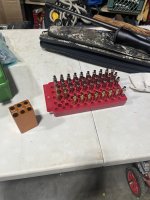
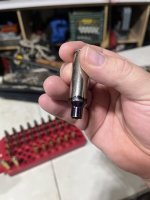
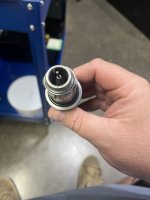
so i went out to my shop and i had 40 cases that where done up with the other loaded ones and they where already fully done and ready and waiting to be reloaded.
so i checked them in my dads rifle like you guys recommended and 8 out of the 40 would not cycle.
so its not a bullet problem, it is a case problem (again, like you guys said)
so i then sharpied one of the problem cases and ran in into the rifle. it gave a very distinct erase of some of the sharpie at the neck.
so i got to thinking about the resizing.
as far as i know im full case resizing, im doing exactly what all the videos online show to do.
so i took out my resizing die and was checking it out and i noticed something.... it was FULL of old grease.
i have been using some paste grease - i think its Lee resizing lube - and the inside of the resizing die was coated in old dried up grease.
so i got some crud buster and went outside and gave it a blast and cleaned it all out, sparkling clean.
then i went and got out a can of Hornady One Shot case lube.
i have never used the stuff but i had seen it on a video and it was a dry lube.
gave the problem case a shot of it.
while it was drying i put back together the resizing die and put it back into the press, got it all set up proper.
took the lubed case and ran it through.
the case cycles in the rifle with NO ISSUE at all.
i went back to my desk and sat down with the case and checked it on the case gauge and its long and needs a trim.
so it was sized and i sized it again and it was able to still push some brass out.
so either the die was so gummed up with old sizing lube that it was not sizing 100% or me resetting the die tightened it up.
ill run the remaining ones through and check them all again.
if none are out of size i will take apart my dad's ladders and redo all of them and check to see if they all come back into spec.
being new at this im still amazed at how small of a issue will cause a bigger issue.
guess im not use to dealing with 0.01 to 0.001 of an inch issues.
some pics



wayupnorth
CGN Ultra frequent flyer
- Location
- Northern Alberta
sorry, that should have said 0.02"
used one of those bullet comparitor deals to measure then put it back 0.02" from there to get the length.
used one of those bullet comparitor deals to measure then put it back 0.02" from there to get the length.
Uhhhhh ...... the headspace specification range is 0.004" from shortest to longest. So you had better get your head around sizing cases to within that dimension or you will run the risk of cases that don't chamber or potentially cases that split at the web and pour 60,000 psi gas into your face. Guessing at stuff is an excellent way to screw it up and you don't want to screw up ammo. Bad things can happen.being new at this im still amazed at how small of a issue will cause a bigger issue.
guess im not use to dealing with 0.01 to 0.001 of an inch issues.
OK, well at least you are using the correct tool for the job.sorry, that should have said 0.02"
used one of those bullet comparitor deals to measure then put it back 0.02" from there to get the length.
Get rid of that case gauge block. Those things are worthless. Make the relevant measurements properly, using the proper tools. Headspace, seating depth and case length. A decent set of calipers and the proper headspace tool and bullet comparator are what is needed.
There should be no lip at the mouth of the case. You must deburr that protuding lip so that it is flush with the rest of the neck.here's a question:
could all this be simply an issue of the lip where the brass ends.... the end of the neck where we trim at?
i ask because we noticed that the rounds i did i heavily chamfered mine and the transition between the bullet and brass is almost no feel.
but the rounds my dad did he didn't chamfer them at all really and the transition is VERY prominent.
in fact he just hand sanded one of the rounds to take off that lip and the round now cycles into the rifle with no issue.
could this all just simply be a issue of not chamfering the outside of the trimmed edge enough???
P.S. I only full-length size my brass, no need to just bump the shoulder, especially for hunting. A clean smooth chambering is most required for hunting.
so, my father and myself started reloading a year or 2 ago.
we have been plugging away at it, getting some excellent results and having a lot of fun while doing it.
recently my dad has been doing up ladders for all his 'good' rifles and he ran into a issue.
while out shooting one of his ladders he stopped being able to load the odd round into the rifle.
it would not cam over when closing.
he came back to my place, talked about it, checked to make sure the primers where not sticking out.
measured the chamber jump with the bullet on a stick thingy.
then he loaded up a bunch more ladders and we went out and today around 70% of his loaded ladder would not load into the rifle, would not cam over.
we are stumped.
what we are going to do is the following.
1) i have the same rifle so tomorrow i will try to load the round into my rifle to make sure that its not his rifle - not a rifle specific issue.
2) i have one of those bullet competitor kits but have never used it, so we will watch a video on that kit and measure up his rounds.
as we are not seeing any marks on the bullet tips i dont think the bullets are too far out and touching the lands and grooves, plus the fact that we measured that and set them back.
im thinking maybe its a shoulder issue?
either the resizer isnt lubed enough and is pulling the necks to long?
im not sure, just spit balling.
any ideas?
The bullet isn't the problem, it's your brass. I suspect your dies aren't set up right. Some presses need to cam over to size properly. Measure a fired piece of brass at the midpoint of the shoulder and compare it to a sized piece - you want -.002 to -.004max. You'll either need a tool to check headspace, or a simple piece of brass/plastic/hardwood with a hole roughly the diameter of the midpoint on your shoulder.
Correct. Probably correct. I'd suggest that all presses need to cam over to ensure the ram extends the exact same distance every time. Without cam over, there is no way to ensure the ram is extended the same distance each time.it's your brass. I suspect your dies aren't set up right. Some presses need to cam over to size properly.
Just out of interest sake, what round is that?
A bullet comparator will only measure the bullet ogive to bottom of case dimension. Good for when you are seating your bullet.
You also need to use a "head space comparator" to find your fired brass dimension of each rifle chamber, and bump back 2 thousands from that measurement. I'm going to assume they will be different in each rifle, but sometimes you get real lucky and they are "close" enough to not worry about brass segregation per rifle. This you have to determine.
https://www.hornady.com/headspace-bushings#!/
You also need to use a "head space comparator" to find your fired brass dimension of each rifle chamber, and bump back 2 thousands from that measurement. I'm going to assume they will be different in each rifle, but sometimes you get real lucky and they are "close" enough to not worry about brass segregation per rifle. This you have to determine.
https://www.hornady.com/headspace-bushings#!/






































































